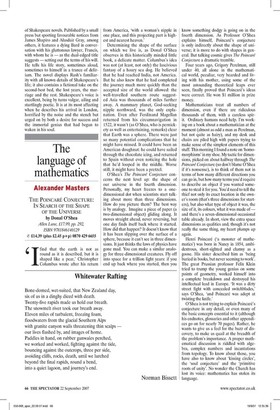The language of mathematics
Alexander Masters THE POINCARE CONJECTURE: IN SEARCH OF THE SHAPE OF THE UNIVERSE by Donal O'Shea Allen Lane, £17.99, pp. 292, ISBN 9781846140129 £14.39 (plus £2.45 p+p) 0870 429 6655 Ifind that the earth is not as round as it is described, but it is shaped like a pear,' Christopher Columbus wrote after his return from America, 'with a woman's nipple in one place, and this projecting part is highest and nearest heaven.'
Determining the shape of the surface on which we live is, as Donal O'Shea observes in this historically minded little book, a delicate matter. Columbus's idea was not (at least, not only) the lascivious fantasy of a hoary sea dog. He believed that he had reached India, not America. But he also knew that he had completed the journey much more quickly than the accepted size of the world allowed: the well-travelled southern route suggested Asia was thousands of miles further away. A mammary planet, God-seeking nipple northward, was the only explanation. Even after Ferdinand Magellan returned from his circumnavigation in 1522, it wasn't (as O'Shea, who is pernickety as well as entertaining, remarks) clear that Earth was a sphere. There were just so many potential complications that he might have missed. It could have been an American doughnut: he could have sailed through the chocolate icing, and returned to Spain without even noticing the hole that he'd looped in the middle. Worse still, it might have been a pretzel.
O'Shea's The Poincare Conjecture concerns the next level up: the shape of our universe in the fourth dimension. Personally, my heart freezes to a onedimensional dot when scientists start talking about more than three dimensions. How do you picture them? The best way is by analogy. Imagine a piece of paper (a two-dimensional object) gliding along. It moves straight ahead, never reversing, but one day finds itself back where it started. How did that happen? It doesn't know that it has been slipping over the surface of a sphere, because it can't see in three dimensions. It just thinks the laws of physics have gone mad. You can make a similar analogy for three-dimensional creatures. Fly off into space for a trillion light years: if you end up back where you started, then you know something dodgy is going on in the fourth dimension. As Professor O'Shea explains himself, Poincare's conjecture is only indirectly about the shape of universe; it is more to do with shapes in general. But talking cosmic gives The Poincare Conjecture a dramatic tremble.
Four years ago, Grigory Perelman, still under 40, all alone in the mathematical world, peculiar, very bearded and living with his mother, using some of the most astounding theoretical leaps ever seen, finally proved that Poincare's ideas were correct. He won $1 million in prize money.
Mathematicians treat all numbers of dimension, even if there are ridiculous thousands of them, with a careless spirit. Ordinary humans need help. I'm working on a book about a mathematician at the moment (almost as odd a man as Perelman, but not quite as hairy), and my desk and chairs are piled high with papers trying to make sense of the simplest elements of this stuff. This morning I found a note on 'Immomorphisms' in my shoe. My tactic for dimensions, picked on about halfway through The Poincare Conjecture (so don't blame O'Shea if it's nonsense), is to think of them not in terms of how many different directions you can go in, but how many terms you'd require to describe an object if you wanted someone to steal it for you. You'd need to tell the thief not only its exact location in the owner's room (that's three dimensions for starters), but also what type of object it was, the size of it, its colours, what it was made of — and there's a seven-dimensional occasional table already. In short, view the extra space dimensions as qualities and, though it's not really the same thing, my heart plumps up again.
Henri Poincare Ca monster of mathematics') was born in Nancy in 1854, ambidextrous, short-sighted and clumsy as a goose. His sister described him as 'being buried in books, but never seeming to work'. The great Prussian professor Felix Klein tried to trump the young genius on some points of geometry, worked himself into a complete breakdown and destroyed his intellectual lead in Europe. 'It was a dirty street fight with concealed switchblades,' says O'Shea, 'and Poincare was adept at twisting the knife.'
O'Shea is not trying to explain Poincare's conjecture in any detail, or even many of the basic concepts essential to it (although his endnotes, glossaries and other appendices go on for nearly 70 pages). Rather, he wants to give us a feel for the buzz of discovery, to make us quail at the breadth of the problem's importance. A proper mathematical discussion is riddled with algebra, complex numbers and incantations from topology. To know about those, you have also to know about 'kissing circles', the 'soul conjecture' and the 'primitive roots of unity'. No wonder the Church has lost its voice: mathematics has stolen its language.

































































 Previous page
Previous page